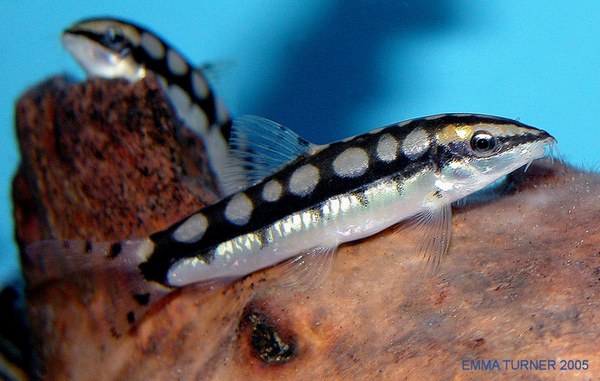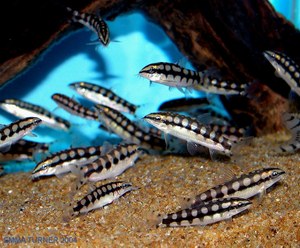Dwarf Loach (Ambastaia sidthimunki)
Summary
Scientific name: Ambastaia sidthimunki (Kottelat, 2012)
Common name: Dwarf Chain Loach, Dwarf Loach, Dwarf Botia, Chipmunk Botia, "Sid".
Synonyms: Botia sidthimunki (Klausewitz, 1959),Yasuhikotakia sidthimunki (Kottelat, 2004)
Distribution: Chao Phraya and Mekong basins - Cambodia, Laos, Thailand.
Sexual Dimorphism: Mature females likely to have a rounder abdominal area.
Maximum size: 6cm (2.5 inches)
Similar to: Juveniles of Ambastaia nigrolineata.

 Care: The Dwarf Chain Loach is an excellent peaceful choice for the mature community aquarium. These fish thrive in large shoals, and 5 really is considered the absolute minumum number to keep together.
Care: The Dwarf Chain Loach is an excellent peaceful choice for the mature community aquarium. These fish thrive in large shoals, and 5 really is considered the absolute minumum number to keep together.
The aquarium should have a fine soft sandy substrate in order to protect the fish's delicate sensory barbel area, and should be furnished with bogwood, rocky caves and aquatic plants. Excellent water quality with a moderate amount of flow should be provided. In nature A. sidthimunki is found in a variety of habitats, some of which are flowing waters, others standing areas of water in flooded regions.
Feeding: Easy to feed - will accept most small foods offered. Sinking catfish pellets, micropellets, flake, algae wafers, and small-sized frozen foods such as Daphnia, cyclops, baby brineshrimp and mosquito larvae are taken with much enthusiasm.
Water parameters: pH: 6.0 -7.5. Hardness: Soft and slightly acidic is best. Max dh: 12.
Temperature: 75ºF to 82ºF (24-28°C)
Breeding: This species is spawned on a large scale via hormone treatment, details of which appear to be a highly guarded trade secret. This is to help take pressure off of the already steep decline in wild stocks.
A number of aquarists have reported signs of probable pre-spawning behaviour in their established large shoals. During the Winter of 2007, Mark Duffill discovered that his A. sidthimunki group had bred and a number of young had survived the attentions of the adult fish. For further details on this fantastic achievement, please click here.
Notes

The smallest member of the Botiine loach group, this species can often be seen exhibiting an unusual behaviour for loaches - that of shoaling above the bottom of the aquarium, often in mid-water, and during daylight hours.
Sadly, A. sidthimunki is now considered as Critically Endangered in it's native Thailand, and is on the IUCN Red List for protection. Formerly numerous in the Kwai Yai, Kwai Noi and Mae Klong Rivers, no recent confirmed catches have been made.
A. sidthimunki was said to have been introduced to the Phillipines during the 1970's, but there is no confirmation as to whether the population established itself.
Still often commands a relatively high price tag in many aquatic centres, and as this species must be kept in large numbers, consideration must be given to the fact that you may have to spend a little more to ensure that your group of fishes are happy. The investment will be repaid in full by the enjoyment you will receive from watching a happy shoal of fish actively swimming around your aquarium searching for tidbits.
A large group of adult A. sidthimunki, playing in amongst plants is a beautiful sight.

Photo Gallery
Click to view all images of this species! |
|
Document Actions

